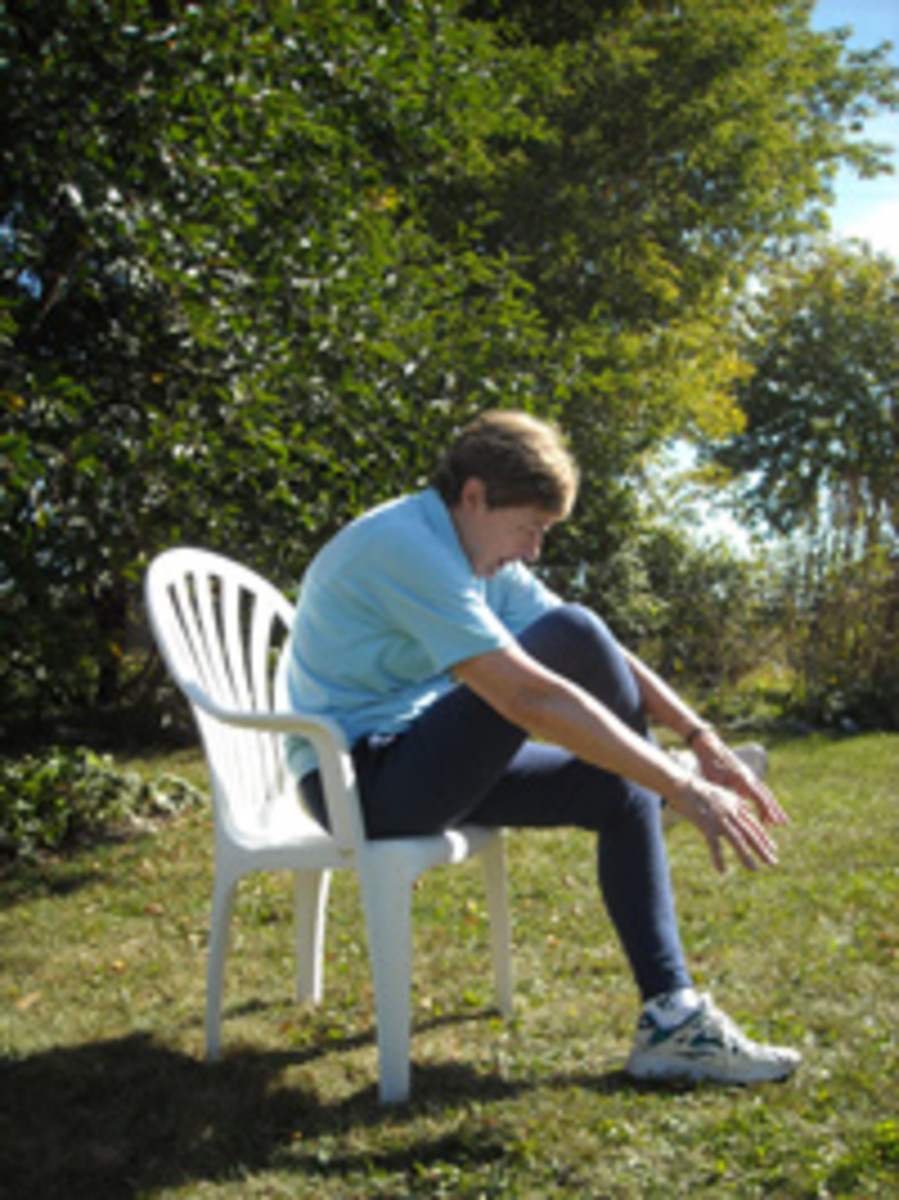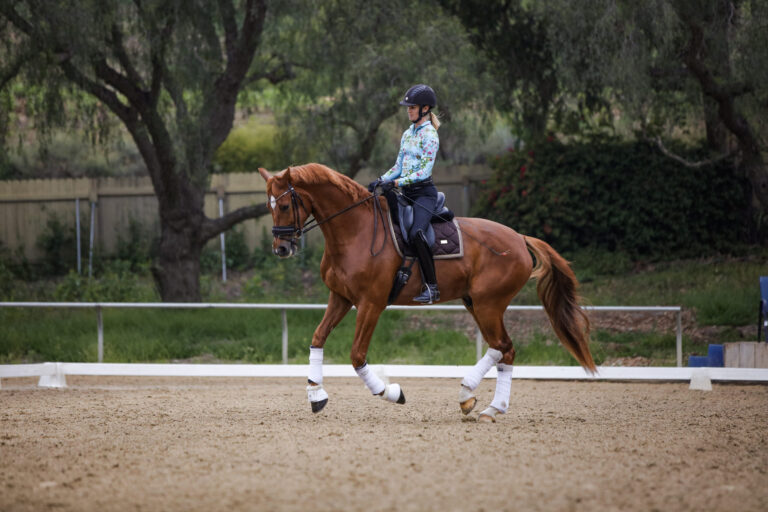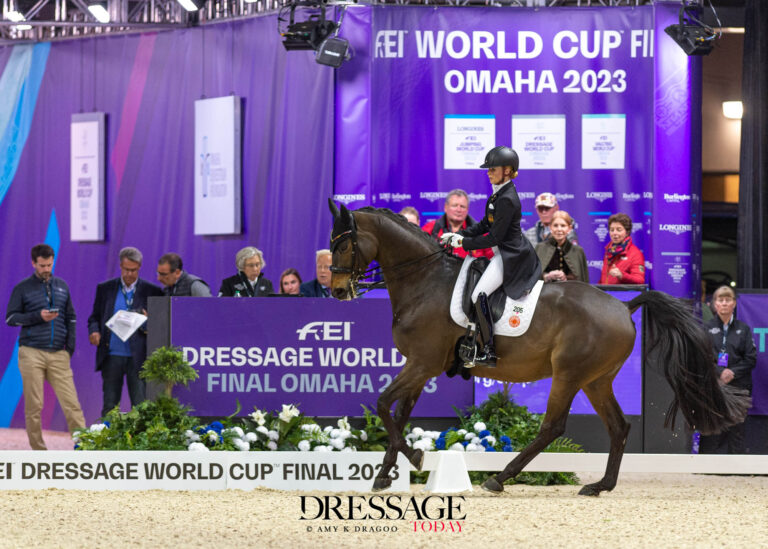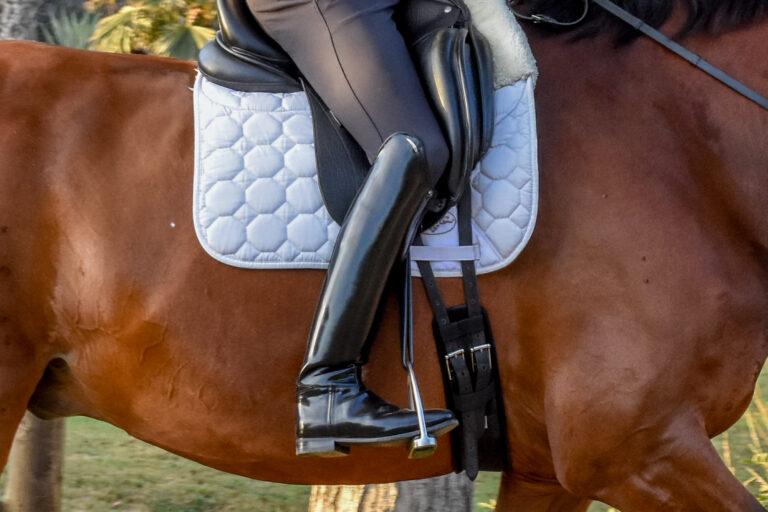In the last month’s article, we looked at fitness for mature riders. One aspect that surfaced was the issue of balance. A common goal at a recent clinic I gave was “getting better balance.” The majority of clinic participants are usually over 40. Though, it’s possible that more middle-aged riders have some extra cash to pay for clinics or are aware of the need for some bodywork in addition to their riding, training balance should not be seen as “therapy for the old gal/guy.” Top athletes in all sports include balance training in their conditioning programs.

Assessing Balance
We often think of balance as separate from other fitness aspects: something you are either born with, or without. While it’s true that people have varying degrees of innate ability for finding their center of gravity, it’s not a static ability. You can improve your balance. In my fitness practice, clients’ ages range from 12 to 83, giving me a wonderful opportunity to observe fitness issues by age group and developmental stage. It’s fairly common for balance to become more of an issue with age. Key factors affecting your balance include ligament and joint flexibility, proprioception, muscle memory and stamina, inner ear infections or blockage, core stability, low blood sugar (not having eaten in a while) and stress or mental “busy-ness.”
Before improving your balance in motion (on the horse), you need to assess and develop your static balance. Of course we know the horse moves under us, but riders to not always break down their own training into static and moving phases. We ride around and around trying to fix something that can’t be fixed effectively in motion: a bit like learning to drive starting at 55 miles per hour. All that is accomplished is the teaching of incorrect muscle memory, since your body uses compensating patterns to stay up there. If you find yourself losing your center of gravity in motion on your horse, it’s definitely time to take it down to the ground and do some work. Take things slowly, and allow your body and brain to “anchor” a more accurate sense of balance before expecting to see large improvements in motion.
Even if you are fairly balanced, it’s a good idea to test yourself on the ground every once in a while. If you are a professional rider, you may not notice changes in your body that will affect your responsiveness to abnormal situations, such as a spook or misbehavior. Testing your balance and proprioception on the ground will give you some guidelines, so you stay flexibility and strong enough for all the situations your riding will put you in. We all want to avoid injury. But, if you ride professionally, downtime may be even more costly to you, and effectiveness even more important.
Riding Posture
While space here does not allow an exhaustive discussion of the key balance factors, let’s summarize by using the riding posture as an example. Riding posture involves what is known in sport conditioning as “triple flexion”–bent ankles, knees and hips. Stacking a straight torso above your legs and hips is the second part of the equation.
As you ride, you make constant adjustment to all joints involved (ankles, knees, hips and the 24 joints in your spine). If you have stiffness in your ankles, tight leg muscles or tight hips, the first three of those joints will not have the right flexion to carry your legs in correct hip to heel alignment. Either your hips or your knees (if you are pinching them) will become a fulcrum: Your upper body will have a tendency to lean or tip either forward or backward, depending on your lower body’s direction off of the vertical line.
Being slightly off of a central plumb line dropping straight down from your seat bones puts you off of your center of gravity: You are already out of balance, even before you start moving. Actually, your body creates a new center of gravity. The problem is it may be over the pommel or cantle instead of over where your seat should be. A shifted center of gravity on a moving horse puts you in perfect readiness to fall off or get very wobbly and insecure for a moment if your horse deviates in rhythm, gait or direction.
Stiffness in any part of the lower body joints will often cause a rider to tense up or stiffen up the upper body to try to create stability in response to the compromised balance–particularly in the shoulders. Alternatively, a rider with a rigid spine may end up with clamping legs as the body tries to compensate for lack of ability to absorb and follow the horse’s motion in the upper half.
If you also have an ear infection, a lower innate sense of balance or weak core–due to lack of training or lack of eating for several hours before your ride–you will be constantly trying to find your balance.
Improve Your Balance
So, what do you do to get better balance? First, eliminate the detractors: stiffness in joints, weakness in thighs, lack of food/sleep/focus. Stretch your ankles (calves), hamstrings, quadriceps and inner thighs a lot so that you have full mobility in the three joints where those muscles cross and can comfortable get your heels under your hips and weight down in your heels. I can’t over-emphasize the importance of stretching your calves at every opportunity. Even if you ride with a really long classical leg and the bottom of your boot is more parallel to the ground, you need the ball of your foot to softly rise as the stirrup is raised slightly by the motion of your horse. Your ankle needs to flex gently up and down. If it is stiff–either due to ligaments in the ankle or a tight calf–your foot will be rigid, and the motion will be sent up your leg. Sometimes, I see riders with floppy lower legs as the motion “escapes” out through movement of the lower leg. Sometimes, I see a seat that has more trouble sitting motion, or what I call the wibble tummy–belly going actively forward and back. The problem with the wibble tummy is that usually the upper back and shoulders of this rider are also rigid in an attempt to create stability above the waist. Then, the lower back gets so much movement that it is often sore, and the lower abdominals are out to lunch since they cannot maintain tone and also allow your lumbar area to move so much. A deep seat and effective half-halts are just about impossible.
Second, strengthen your legs through exercises, such as squats. Using a destabilizing object or doing squats on one leg will really help you work on proprioception and the small stabilizing muscles in your legs and hips at the same time. Another exercise that helps with basic proprioception and development of your stabilizing muscles is simply standing on one leg while shifting your other leg around in all directions. You can start with a hand on the wall or other object to help stabilize you. Eventually, you should be able to perform shallow single-leg squats without your knee wobbling in or out or hip poking out.
Your goal with all such exercises is to maintain the same degree of bend in all three leg joints, and keep your hip/heel alignment. Keep your torso upright and lower abdomen pulled up, just as you need to in the saddle. You are teaching your body to “feel” straightness. If you also tense up your shoulders doing the exercises, you are mostly likely doing so in the saddle. Practicing correct alignment and balance while maintaining looseness and relaxation in your shoulders will help your mind separate muscle firing signals which you need to be able to do to simultaneously relax some areas while engaging others as you ride. Practicing the same thing on a balance object, such as a balance board, bosuT, pod , a pool noodle or a couple of tennis balls will help you transfer static balance to balance in motion.
If you have a head cold or ear infection, you may need to really concentrate and focus to achieve straightness and balance. If you are overweight, you may need to lose some weight to remove some of the “loose ballast” that shifts involuntarily on you. If you find that you get out of breath riding, you have insufficient cardiovascular ability for your riding. Your muscles and brain are not getting oxygen at the rate needed, and you will be compromising your neuro-muscular accuracy. In other words, balance will be more of a challenge.
Exercises
Balance Squats: Valerie, 79, is performing a simple squat. Differences here are that she has one foot on an unstable object (balance pod) and one hand on a chair to help balance. Using the chair is a smart safety move: Her body is still learning to negotiate and stabilize on the pod, and she is still working on leg and back strength performing the squat.

Leg Work on a Ball: As a strength exercise, the leg extension builds quadriceps strength. Done on the ball, Valerie must pay attention to pressure on her seat bones. To remain straight and symmetrical, she must simultaneously engage her core, so the exercise has multiple benefits affecting balance, strength and posture.

Seated Hip Stretch: Hip flexibility is a very important part of hip stability–and therefore balance. You can do this stretch lying on your back on the floor for more stability or on a ball for more challenge as a balancing exercise. Here, Valerie is doing the stretch by simply leaning forward while seated on a firm chair, so she can concentrate on the stretch itself without too much worry about losing her balance. If you have high or low blood pressure, the seated posture may be more advisable than lying on your back.



Heather Sansom owns Equifitt.com Equestrian Fitness, offering personalized coaching through clinics and convenient online coaching available anywhere. She also offers a free monthly fittips newsletter and new e-books, Complete Core Workout for Riders and Handy Stretching Guide for Riders, at Equifitt.com.











